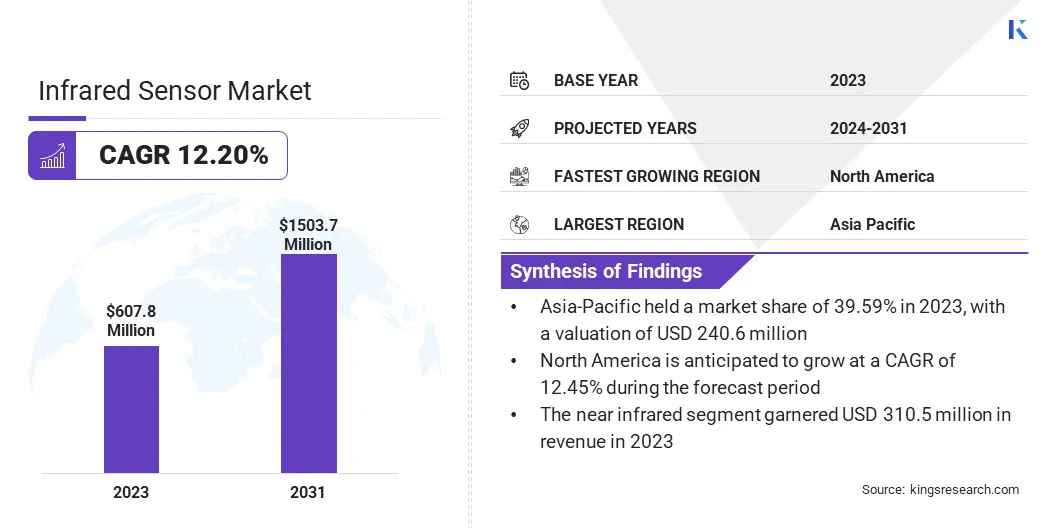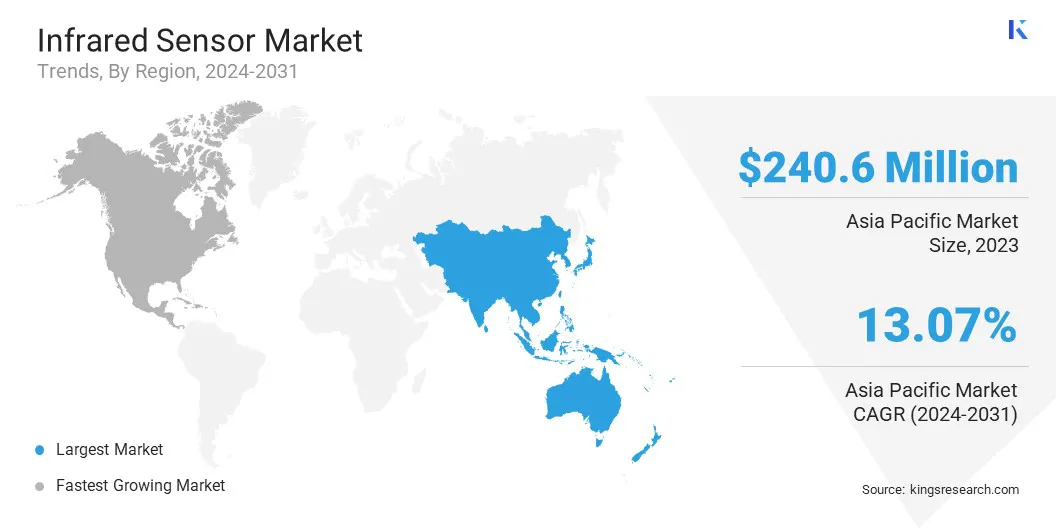Infrared Sensor Market Size
The global Infrared Sensor Market size was valued at USD 607.8 million in 2023 and is projected to grow from USD 671.8 million in 2024 to USD 1,503.7 million by 2031, exhibiting a CAGR of 12.20% during the forecast period. The market is expanding due to the rising need of industries to enhance their monitoring and measurement capabilities.
Major factors driving growth include the rising demand for high-resolution imaging, increasing adoption of infrared technology in industrial applications, and advancements in sensor materials and manufacturing techniques. Additionally, the need for precise temperature measurements and non-contact sensing in diverse fields, such as manufacturing and environmental monitoring, is contributing to the market's growth.
In the scope of work, the report includes solutions offered by companies such as FLIR Systems, Inc., Hamamatsu Photonics K.K., Murata Manufacturing Co., Ltd., Texas Instruments Incorporated, RTX, Honeywell International Inc., Omron Automation, Teledyne Technologies Incorporated, Excelitas Technologies Corp., Lynred, and others (Please make sure to use only copyright names of the listed companies).
The infrared sensor market is experiencing significant growth, driven by their rising demand across various sectors such as automotive, consumer electronics, security, and healthcare. Infrared sensors are increasingly being adopted for various applications including autonomous vehicles, night vision systems, and thermal imaging, due to their ability to perform efficiently in low-light conditions.
- A notable instance is the Delhi government's recent decision to install 140,000 surveillance devices under the second phase of its CCTV camera project, with plans to install an additional 140,000 devices.
Such large-scale deployments are propelling the market forward, with strong growth potential in emerging as well as established markets.
An infrared sensor is a device that detects and measures infrared radiation emitted by an object based on their temperature. These sensors convert infrared radiation into electrical signals that can be analyzed to determine temperature, motion, or the presence of objects. Infrared sensors are used in a variety of applications, including thermal imaging, night vision, and proximity sensing.
They are integral to systems requiring non-contact measurements and operate effectively in low or no-light conditions. Infrared sensors operate by detecting specific wavelengths of infrared light and are essential for applications ranging from industrial monitoring to security and consumer electronics.

Analyst’s Review
The increasing need for advanced aerial surveillance and threat detection systems in military, aviation, and defense sectors is fueling market growth. The demand for enhanced targeting and tracking capabilities in fighter aircraft is propelling the development of sophisticated infrared sensors.
- For instance, in October 2022, Tactical Air Support Inc. (Tactical Air) partnered with Lockheed Martin to conduct initial flight tests of TacIRST, a new class of long-range infrared search-and-track sensors. This development made Tactical Air's F-5 Advanced Tiger the first fighter aircraft to integrate and test TacIRST, underlining its importance in enhancing threat replication systems for the U.S. Air Force and Navy.
Key players are focusing on advancements in infrared sensor technology to enhance market growth by investing in innovative solutions and strategic collaborations. By developing advanced systems for defense, automotive, and consumer applications, they are meeting evolving demands and expanding their market presence, aiding industry advancement.
Infrared Sensor Market Growth Factors
The increasing adoption of autonomous vehicles is propelling the growth of the infrared sensor market. As the automotive industry is moving toward greater autonomy, companies are increasingly relying on advanced infrared sensors for critical functions such as night vision systems, object detection, and pedestrian recognition.
These sensors are enhancing vehicle safety and performance by providing reliable detection and imaging in low-light conditions. Therefore, the growing dependence on infrared technology is driving significant market expansion, as manufacturers are continuously integrating these sensors to meet the evolving safety and performance demands of autonomous vehicles.
A significant challenge hindering the market is the high cost of advanced infrared technologies. The expense associated with manufacturing and integrating high-performance sensors can be prohibitive for smaller companies and limit widespread product adoption.
In addition, the complexity of infrared sensor systems requires specialized knowledge and expertise, which can further restrict market growth. Key players are addressing these challenges by investing in research and development to reduce production costs and enhance sensor efficiency. They are focusing on technological advancements and economies of scale to make infrared sensors more affordable and accessible. Collaborations and partnerships with industry stakeholders are also helping to share costs and expertise, thus accelerating market growth and innovation.
Infrared Sensor Market Trends
Growing concerns around security and surveillance are propelling the demand for infrared sensors, particularly in advanced thermal imaging applications. For instance, companies are increasingly integrating infrared sensors into thermal imaging cameras for intruder detection, perimeter monitoring, and threat identification in low-light or challenging environmental conditions.
The ability of these sensors to deliver precise imaging in total darkness is positioning them as essential components in modern security systems. This increased reliance on infrared technology is driving significant investment and adoption across various sectors, fueling the market growth.
The growing trend of miniaturization and improved power efficiency is also actively shaping the infrared sensor market. Companies are continuously developing more compact and energy-efficient infrared sensors, making them increasingly cost-effective and suitable for a broader range of applications. These advancements are enabling the integration of infrared sensors into portable and battery-operated devices across various industries, including consumer electronics, healthcare, and wearables. As demand for these compact and efficient sensors grows, the market is anticipated to experience robust expansion.
Segmentation Analysis
The global market is segmented based on the type, application, end use, and geography.
By Type
Based on type, the market is categorized into near infrared, infrared, and far infrared segments. The near infrared segment led the infrared sensor market in 2023, reaching a valuation of USD 310.5 million, mainly driven by its increasing application in night vision systems and automotive safety features.
NIR or near infrared sensors, which detect wavelengths adjacent to the visible light spectrum, offer superior photon detection in low-light conditions compared to thermal cameras. This capability enhances their value for night vision applications. A significant growth driver is the European New Car Assessment Programme (Euro NCAP), which began rewarding manufacturers for integrating Child Presence Detection systems as standard features in vehicles starting 2022.
Such regulatory initiatives lead automakers and suppliers to adopt advanced NIR sensing technologies to meet new safety standards. As a result, the NIR sensors segment is poised for significant expansion, reflecting their growing importance in both automotive and broader imaging applications.
By Application
Based on application, the market is categorized into motion sensing, temperature measurement, security and surveillance, gas and fire detection, spectroscopy, and others. The security and surveillance segment captured the largest infrared sensor market share of 30.95% in 2023.
The demand for sophisticated solutions, such as high-resolution cameras and integrated sensor systems, is expanding as businesses and governments seek to enhance their surveillance capabilities. Innovations in infrared and near-infrared sensors are particularly impactful, providing improved night vision and object detection.
Additionally, regulatory requirements and public safety initiatives are also accelerating the adoption of these technologies. As the need for comprehensive security solutions grows, this segment is set to see substantial market expansion over the forecast period.
By End Use
Based on end-use, the market is categorized into healthcare, aerospace and defense, automotive, commercial applications, oil and gas, and other. The healthcare segment is expected to garner the highest revenue of USD 501.2 million by 2031, due to the increasing adoption of non-invasive diagnostics and monitoring technologies.
Infrared sensors are crucial in applications such as temperature monitoring, imaging, and patient monitoring systems. Their ability to provide accurate, real-time data without direct contact enhances patient comfort and diagnostic precision. Advances in sensor technology are driving innovation in thermal imaging and wearable health devices, further boosting market demand.
As healthcare providers and researchers prioritize advanced, non-invasive solutions for patient care and diagnostics, the growth of the market in this sector is expected to continue expanding rapidly.
Infrared Sensor Market Regional Analysis
Based on region, the global market is classified into North America, Europe, Asia-Pacific, MEA, and Latin America.

Asia-Pacific infrared sensor market share stood around 39.59% in 2023 in the global market, with a valuation of USD 240.6 million. The market in the region is driven by rapid industrialization, technological advancements, and increasing investments in security and healthcare infrastructure. Countries like China, India, and Japan are leading the market due to significant investments in manufacturing, automotive, and smart city projects.
- For instance, the Department for Promotion of Industry and Internal Trade (India) recently reported that the Indian automobile sector received approximately USD 1.6 billion in foreign direct investment.
The increased versatility of infrared sensors, particularly in far infrared (FIR) applications for enhanced road and surroundings detection in autonomous vehicles, is significantly contributing to market growth. Government initiatives promoting technological innovation and urban development are further fueling market demand.
North America is anticipated to witness significant growth at a CAGR of 12.45% over the forecast period driven by its advanced technological landscape and significant investments in defense and aerospace sectors. The U.S. and Canada are key contributors, witnessing increased adoption of infrared sensors in military applications, security systems, and industrial automation.
- For instance, in December 2022, Leonardo DRS received a contract to supply the US Army with third-generation FLIR sensors. This contract included the initial low-rate production of the FLIR Dewar Cooler Bench (DCB) long-range sensor, which is set to replace the current second-generation Horizontal Technology Integration (HTI) sensors.
The presence of major technology companies and defense contractors is fostering innovation and driving market expansion, positioning North America as a leading player in the global market.
Competitive Landscape
The global infrared sensor market report will provide valuable insights with an emphasis on the fragmented nature of the industry. Prominent players are focusing on several key business strategies, such as partnerships, mergers and acquisitions, product innovations, and joint ventures, to expand their product portfolio and increase their market shares across different regions.
Companies are implementing impactful strategic initiatives, such as expanding services, investing in research and development (R&D), establishing new service delivery centers, and optimizing their service delivery processes, which are likely to create new opportunities for market growth.
List of Key Companies in Infrared Sensor Market
- FLIR Systems, Inc.
- Hamamatsu Photonics K.K.
- Murata Manufacturing Co., Ltd.
- Texas Instruments Incorporated
- RTX
- Honeywell International Inc.
- Omron Automation
- Teledyne Technologies Incorporated
- Excelitas Technologies Corp.
- Lynred
Key Industry Development
- August 2023 (Product Launch): Vishay Intertechnology, Inc. unveiled three new compact infrared (IR) sensor modules for remote control systems. These Vishay Semiconductors modules—the dual-lens TSMP95000 and the single-lens TSMP96000 and TSMP98000—featured modulated carrier output for code learning applications.
The global infrared sensor market is segmented as:
By Type
- Near Infrared
- Infrared
- Far Infrared
By Working Mechanism
By Application
- Motion Sensing
- Temperature Measurement
- Security and Surveillance
- Gas and Fire Detection
- Spectroscopy
- Others
By End Use
- Healthcare
- Aerospace and Defense
- Automotive
- Commercial Applications
- Oil and Gas
- Other
By Region
- North America
- Europe
- France
- UK
- Spain
- Germany
- Italy
- Russia
- Rest of Europe
- Asia-Pacific
- China
- Japan
- India
- South Korea
- Rest of Asia-Pacific
- Middle East & Africa
- GCC
- North Africa
- South Africa
- Rest of Middle East & Africa
- Latin America
- Brazil
- Argentina
- Rest of Latin America


